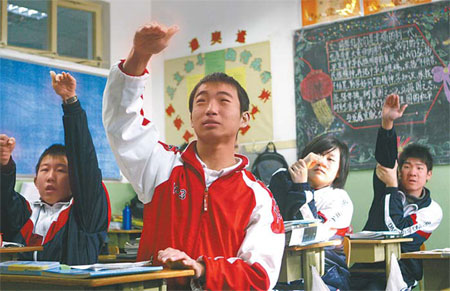Breaking the silence
 |
| Learning English for the hearing-impaired students is a full-body experience. Guo Yingguang |
These are eighth-grade students from Beijing No 3 School for the Deaf in an English class.
The stomping creates vibrations, which helps them get each other's attention. And yelling, which is unintentional, comes from what's left of their vocal cords. Their hand gestures are finger-spellings of Chinese phonetics, and the enthusiasm - well, the kids wanna learn.
While a full-hearing person learns to spell by the sound of the words, a deaf person has to memorize the sequence of the letters by heart.
At Beijing No 3 School for the Deaf, reading and writing oral languages is integrated into the teaching of every subject from fine arts to mathematics.
The most important tool for deaf people to interact with mainstream society hinges on their Chinese reading and writing abilities, says Sun Yan, a special-education English teacher at the school.
However, it is extraordinarily difficult to switch from a visual language to an oral language, says Sun, who combines sign language, finger-spelling, Mandarin and English in her teaching.
In learning an oral language, deaf students are confronted with an entirely alien and unnatural method of expression, says Sun. They need to overcome obstacles unimaginable to a hearing person.
With all these obstructions, doesn't it seem a little ambitious, if not unrealistic, for a deaf student to learn English - a second oral language?
"It is extremely difficult," says Xue Xiaoxia, another English teacher at the school. "Sometimes the students find the Chinese translations as incomprehensible as the English."
English classes - which used to be available only to seniors as an extracurricular activity - became mandatory at the school in 2001, when the Ministry of Education decided to include the subject in the college entrance exams for the deaf.
English classes at the school exist "to a large extent" for the exams, Sun admits.
Students now begin English classes as early as fourth grade. After eight or nine years of study, students are tested at a level that is one year below that of hearing students for the college entrance exams.
In a typical English class, students use a complex mixture of pinyin finger-spelling, sign language and lip-reading.
They mouth the letters and gesture with their hands, and stand up or wave to get the teacher's attention. Here, learning is a full-body experience.
Teaching and learning are even more difficult, as there are no special English textbooks for the deaf. At the start of each school year, the five teachers at the school edit the latest versions of the standardized textbooks and adapt them to the needs of deaf students.
"We get rid of the speaking and listening components and replace them with more reading and composition," says Sun.
Despite the difficulties, English teacher Gu Yan believes it's necessary for deaf students to learn English, because it helps them learn about other countries.
Most deaf students have little idea what's going on outside of school, because they have minimal contact with society and few sources of information, says Sun.
Sun believes a deaf person's native tongue is sign language, and his second language is the native oral language of his country.
English, then, is the third language for 20-year-old student Xu Chengcheng.
Although spelling is very hard, English is one of her favorite subjects, Xu says, through one of the school's administrators who volunteered to be her interpreter.
Like 80 percent of students at the school, Xu lives in a campus dormitory room with seven others.
"The only hearing people I interact with are my family, teachers and a few neighbors," says Xu.
At 20, Xu is competing in a national dancing tournament for disabled people, where she hopes to make new friends. Unlike Xu, most students hardly leave campus, dreading the long summer holidays when they have to leave school.
For them, the school is a community of discovery. "I found something," gestures an excited student in sign language.
He runs up to the lectern and points to the word "vegetable". Then he gestures towards the table, smiling widely. He has found the word "table" in "vegetable".
The class praises his discovery with wild applause.
A red light starts blinking over the blackboard, the students stand up and choreograph a "goodbye" to the teacher.
The class is over, but the teaching goes on.
(China Daily 11/30/2007 page18)














